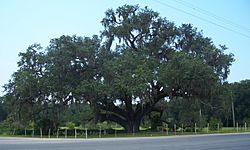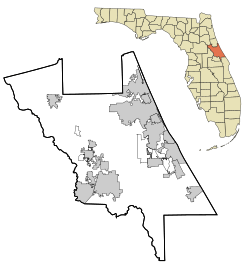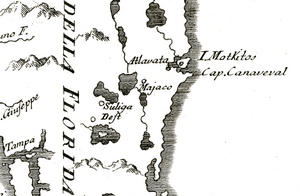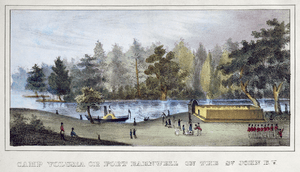Volusia, Florida facts for kids
Quick facts for kids
Volusia
Maiaca
Volusia Landing
|
|
|---|---|

Historic oak near the St. Johns River
|
|
| Nickname(s):
"Town of Many Forts"
|
|
| Country | |
| State | |
| County | Volusia |
| Settled | Before 1558 |
| Area | |
| • Total | 1.8 sq mi (5 km2) |
| Elevation | 16 ft (5 m) |
| Population
(2010) Estimated by adding count in all census blocks overlapping area of Volusia
|
|
| • Total | 596 (estimate) |
| Demonym(s) | Volusian |
| Time zone | UTC-5 (Eastern (EST)) |
| • Summer (DST) | UTC-4 (EDT) |
| ZIP code |
32102
|
| Area code(s) | 352 |
| GNIS feature ID | 306545 |
Volusia is a small community in Volusia County, Florida, United States. It sits on the eastern side of the St. Johns River. The community is about three miles south of Lake George. Across the river is the town of Astor.
Volusia is one of Florida's oldest European settlements. Spanish missionaries first set it up a long time ago. The main road through town is State Road 40. This road crosses the St. Johns River on the Astor Bridge.
Volusia County gets its name from this community. The name "Volusia" was used as early as 1815. Before Europeans arrived, the Mayaca people lived here in 1558. Since then, different forts and trading posts have been built here. These were used by the Spanish, British, and Americans. The St. Johns River was a very important travel route. In the 1830s, there were fights with the Seminole people. The U.S. government wanted them to move west.
Exploring Volusia's Past: A Journey Through Time
Early People: The Mayaca Tribe
The native Mayaca people lived in much of the area now called Volusia County. They lived along the St. Johns River. A village south of Lake George was called Maiaca. This was probably the biggest Mayaca village.
Some history books say the native Timucua people lived in large parts of Florida. This included areas along the St. Johns River. However, other sources suggest the Mayaca were a different group. They had their own language, customs, and villages. Smaller native groups often formed alliances. The village of Mayaca was sometimes part of the Outina group. Other times, it was allied with the Saltwater Timucua.
In 1691, a Spanish missionary named Francisco de Ayeta described the Mayaca. He said they lived south of the Freshwater Timucua land. He noted they were a "wild nation" who did not want to settle down. They also did not plant crops or live in one place.
Spanish Rule: Missions and Forts (1566-1763)
The first European mention of Volusia was by Hernando de Escalante Fontaneda. In his writings from 1558-1575, he talked about Mayaca.
In 1566, Pedro Menéndez de Avilés traveled up the St. Johns River. He met with important chiefs, called caciques. He wrote about meeting a chief named Macoya. This is thought to be the same place as the Mayaca mission. After Menéndez went further upriver, Macoya threatened him with war.
By 1602, Spanish Franciscan missionaries had built a church at Mayaca. They reported 100 native people there who had not yet been baptized. The Spanish generally thought the Mayaca were different from the Timucua. This was true even though they lived in what was thought to be Timucuan land.
The mission of San Salvador de Mayaca was listed in 1655. In 1657, the mission church was built on old shell mounds. These mounds were made by the Mayaca people. This is where present-day Volusia is located.
Around 1680, colonists settled the area. It became the second-oldest Spanish base in Florida. Only St. Augustine was older. The Spanish built a fort called Antonio de Anacape in 1680. Pieces of mortar from this fort have been found near Volusia's Landing.
In 1689, the Spanish listed missions where Timucua was spoken. This list included San Antonio de Mayaca with 30 families. This was about 150 people. However, historians now believe the Mayaca people did not speak Timucua.
A Spanish count in 1717 mentioned the native village of San Joseph de Jororo. It said 33 native people lived there. By the mid-1700s, many Mayaca people had died. This was due to attacks from northern tribes like the Yamassee and Euchees.
British Control: Trading Posts (1763-1783)
In 1763, Great Britain won the Seven Years' War. They traded with Spain to take over East Florida. James Spaulding and Roger Kelsall opened five stores in Florida. One of these was in Volusia. It was called Spaulding's "Upper Store." This store likely operated near Volusia from 1765 to 1787.
Spain Returns: More Trading (1783-1819)
After the American Revolutionary War, the British gave Florida back to Spain. This was part of the Treaty of Versailles. The United States allowed James Spaulding's stores to keep running.
Spaulding's Upper store later belonged to Panton, Leslie & Company. It was known as Panton, Leslie Trading House. It operated in Volusia from 1787 until at least 1834. The name "Volusia" first appeared as a place name in 1815. It was in Spanish land records.
American Era: Growth and County Naming (1819-Present)
By 1822, Volusia was described as a "very fine tract" of land. It was on both sides of the St. Johns River. Most of it was on the western side. The settlement was started about three years earlier by Horatio S. Dexter.
On December 29, 1854, Florida's government divided Orange County. They created a new county called Volusia County. It was named after its largest community, Volusia. At that time, Volusia County had about 600 people.
What's in a Name? The Origin of Volusia
The exact origin of the name Volusia is not fully known. There are no old documents that explain it. However, there are several ideas:
- Euchee Land: Some believe the name comes from a word meaning "Land of the Euchee." The Euchee people moved into the area after the Timucua cultures disappeared. This was in the early 1700s. The Euchee lived between Spring Garden and Lake George. Before 1815, this area was called Euchee territory. The name Volusia was spelled Velutia by the French and Volucia by the Spanish.
- Mr. Voluz's Plantation: Another idea is that the name came from a British man named Voluz. He owned a plantation in the late 1700s. This plantation was on the St. Johns River.
- Veluche's Trading Post: Some say the name came from Veluche. This was the last name of a French or Belgian owner of a trading post in Volusia. Some say this was during British rule. Others say it was around 1818, after the United States took over. Over time, the name Veluche became "Volusia."
- Jere Volusia: One theory suggests the town was started by and named for a person called Jere Volusia.
- Roman Jurist: Another idea is that the Spanish named the settlement after Lucius Volusius Maecianus. He was a famous Roman lawyer. He wrote many books and taught Marcus Aurelius, a Roman emperor.





